
Damaged tiles should be fixed right away. In this guide, find out all of the different factors that affect your tile repair cost.
Make a splash with a non-traditional backsplash design


While it’s true that tile is the most common backsplash material—it’s not your only option. There are plenty of beautiful and affordable backsplash alternatives that will not only protect your walls from those pesky cooking spills but will also add a skosh of style to your space.
| Backsplash Alternative | Biggest Benefit |
|---|---|
| Paint | Inexpensive |
| Wallpaper | Bold patterns |
| Stone slabs | Sophisticated design |
| Metal sheet | Commercial look |
| Wood panels | Rustic look |
| Exposed brick | Vintage design |
| Glass | More natural light |
| Mosaic pieces | Personalized design |
| Poured concrete | Industrial look |
| Copper penny | Unique appearance |
| Chalkboard | Artistic vibe |
| Peel-and-stick tile | Easy to install |
| Wall decals | Temporary |
| Stone veneer | Mimics real stone |
| Beadboard | Cozy feel |
| Wall stencil | Customizable |
| Laminate | Versatile |
| Subway tile | Timeless design |
Using washable paint instead of a traditional backsplash material can help if you’re wondering how to save money on your kitchen remodel. Considering the cost of a kitchen backsplash averages about $1,000, using paint as the backsplash should save you quite a bit of cash. You also can change the color whenever you want. Some people choose chalkboard paint, so they can write recipes, shopping lists, or inspirational messages for their families. If you go this route, be sure to use washable and stain-resistant paint.
| Pros | Con |
|---|---|
| Easy to apply | Minimal protection |
| Stain resistance | Very basic design |
| Inexpensive | Can peel or chip |
Best for: Those who want to change the backsplash color frequently, while saving money.
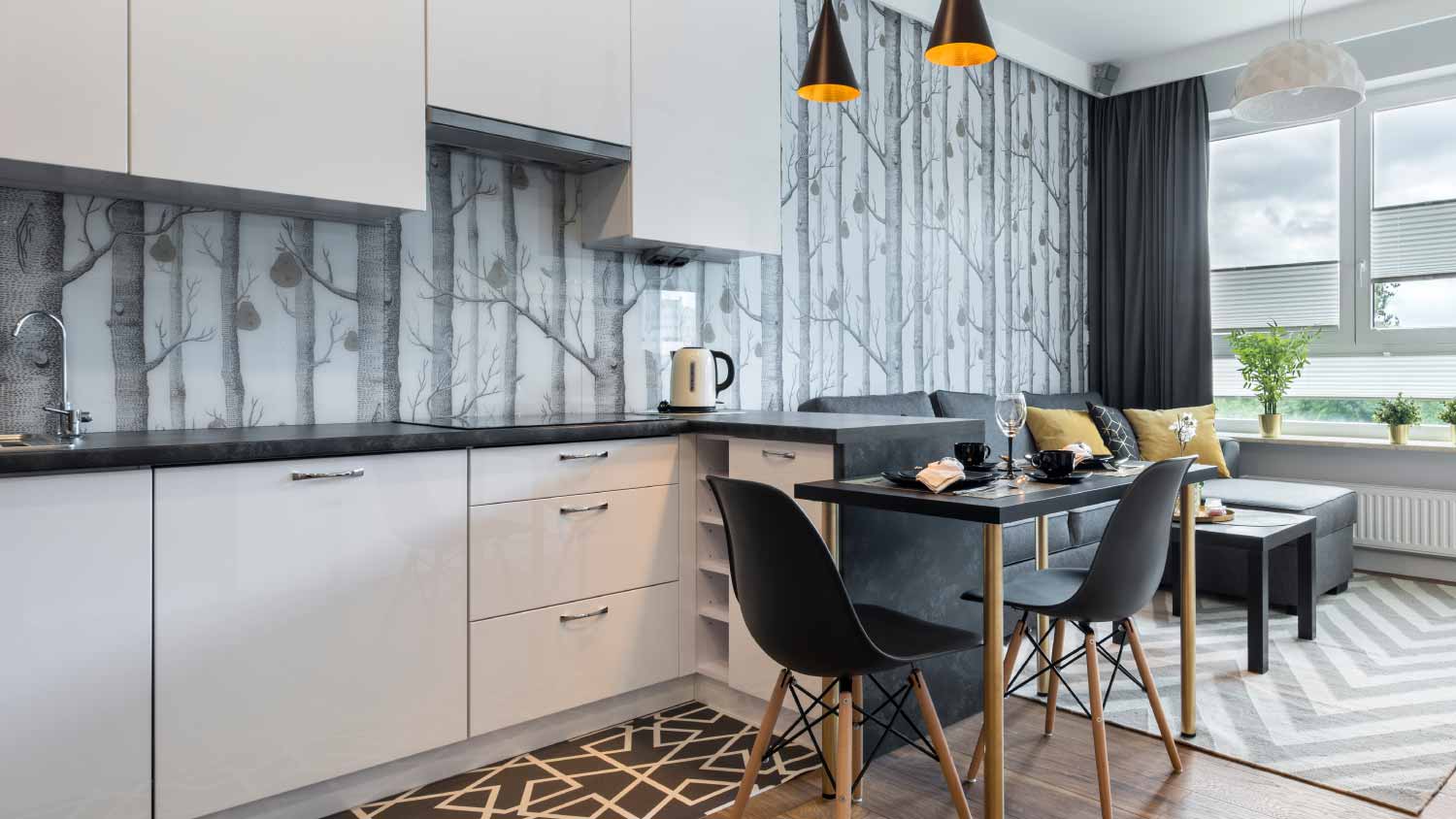
Although wallpaper could suffer discoloration with splattered food, the bold patterns and colors in a wallpaper backsplash can transform your kitchen like few other materials. The almost unlimited number of patterns allows you to let your personal style show through. You may need to cover it with glass or varnish, though, to fully protect it.
| Pros | Cons |
|---|---|
| Multiple patterns | Needs protection |
| Easy to clean | May peel or discolor |
Best for: Those who want to make a bold statement in an eclectic kitchen design.
If you’re redoing your countertops, you may want to use the same material for your backsplash. By using the slab instead of tile, you don’t have to worry about grout lines. Natural stone backsplashes are extremely durable and create a seamless look in the kitchen. However, this isn’t a DIY backsplash job. You’re better off hiring a local backsplash installer to secure the slab to the wall.
| Pros | Cons |
|---|---|
| Ties into counters | Not DIY-able |
| No grout lines | Thick material |
| Sophisticated look | Pricier option |
Best for: Those who want to match the look of the countertops in the backsplash.
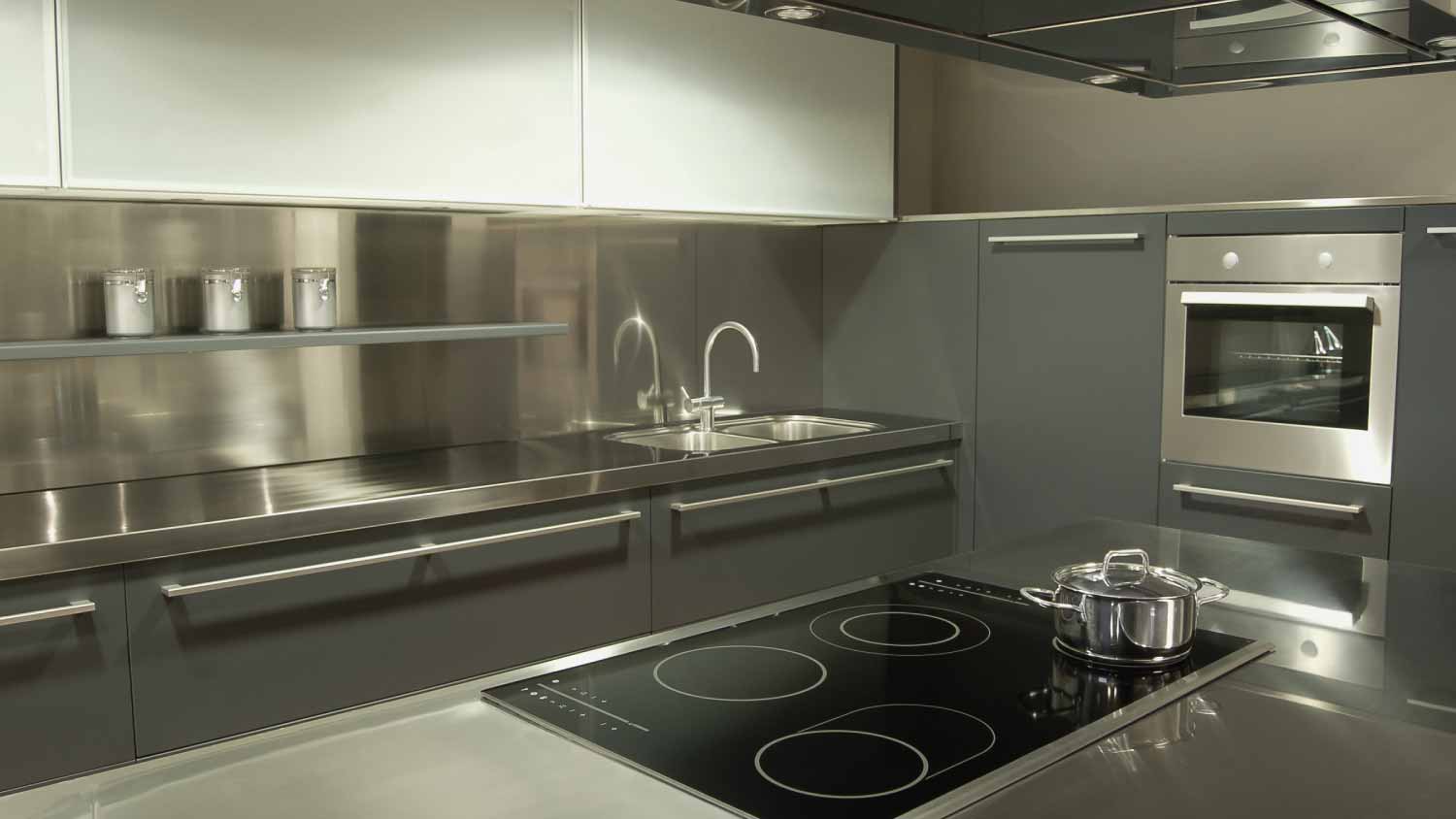
Adding a sheet of metal is one of the most interesting backsplash alternatives you can select. Both copper and stainless steel add warmth to the kitchen design. These materials can be pricey to add over a large space, but few other backsplash materials are quite as distinctive. The metal may show water marks, but it is durable and easy to wipe down after a spill.
| Pros | Cons |
|---|---|
| Adds warmth and beauty | Shows water spots |
| Easy to wipe off | Expensive material |
Best for: Those who want to facilitate a commercial design in the kitchen.
Using wood planks as your backsplash delivers a rustic look that few other materials can match. The natural wood grain and variety of stain color options let you customize the design to match your exact tastes. You can even use pre-cut flooring planks or painted shiplap, if desired, to simplify installation. Layout variations and patterns are possible, too. Herringbone patterns can deliver a unique look, for example.
However, wood isn't very protective because of its vulnerability to water damage. It requires a protective coating of paint, lacquer, polyurethane, or similar products to help it do its job.
| Pros | Cons |
|---|---|
| Offers rustic look | Must seal it |
| Multiple styles | Can warp from moisture |
Best for: Those who want to create a rustic, natural look.
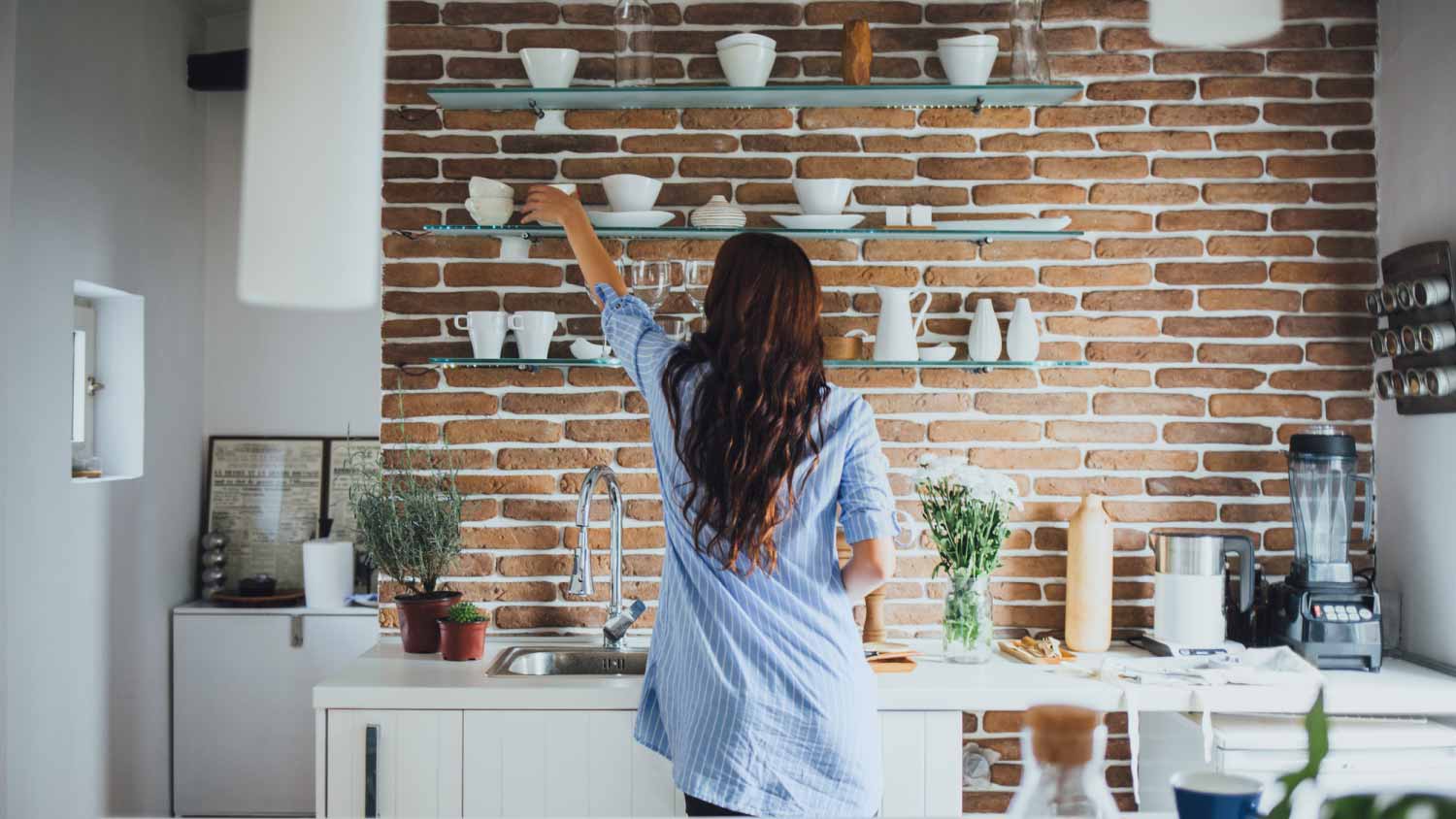
Nothing quite matches the vintage feel of using exposed brick inside your home, whether in an accent wall or a chimney. You can carry this same feel into the kitchen by using exposed brick as a backsplash alternative to tile. You can buy faux brick tiles to simplify delivering the desired look in the kitchen, although you can also hire a mason to cut real bricks in half and install them as veneer.
| Pros | Cons |
|---|---|
| Vintage design | Challenge to clean |
| Can use faux bricks | Must be sealed |
| Paintable | May require a mason |
Best for: Those who want to emphasize a vintage design or mimic an accent brick wall elsewhere in the home.
Add a splash of elegance to your modern kitchen design by installing a glass backsplash. You can add lighting at the edges for an accent. Some people choose mirrored glass to make a small kitchen feel larger. If the kitchen wall is an exterior wall, consider installing window glass in the backsplash location to add natural lighting or to give you a clear look at your backyard while cooking.
| Pros | Cons |
|---|---|
| Natural light and outdoor view | Shows spots and grime |
| You can add accent lighting | Difficult to install |
| Modern design | Expensive |
Best for: Those who want to enhance a modern kitchen design.
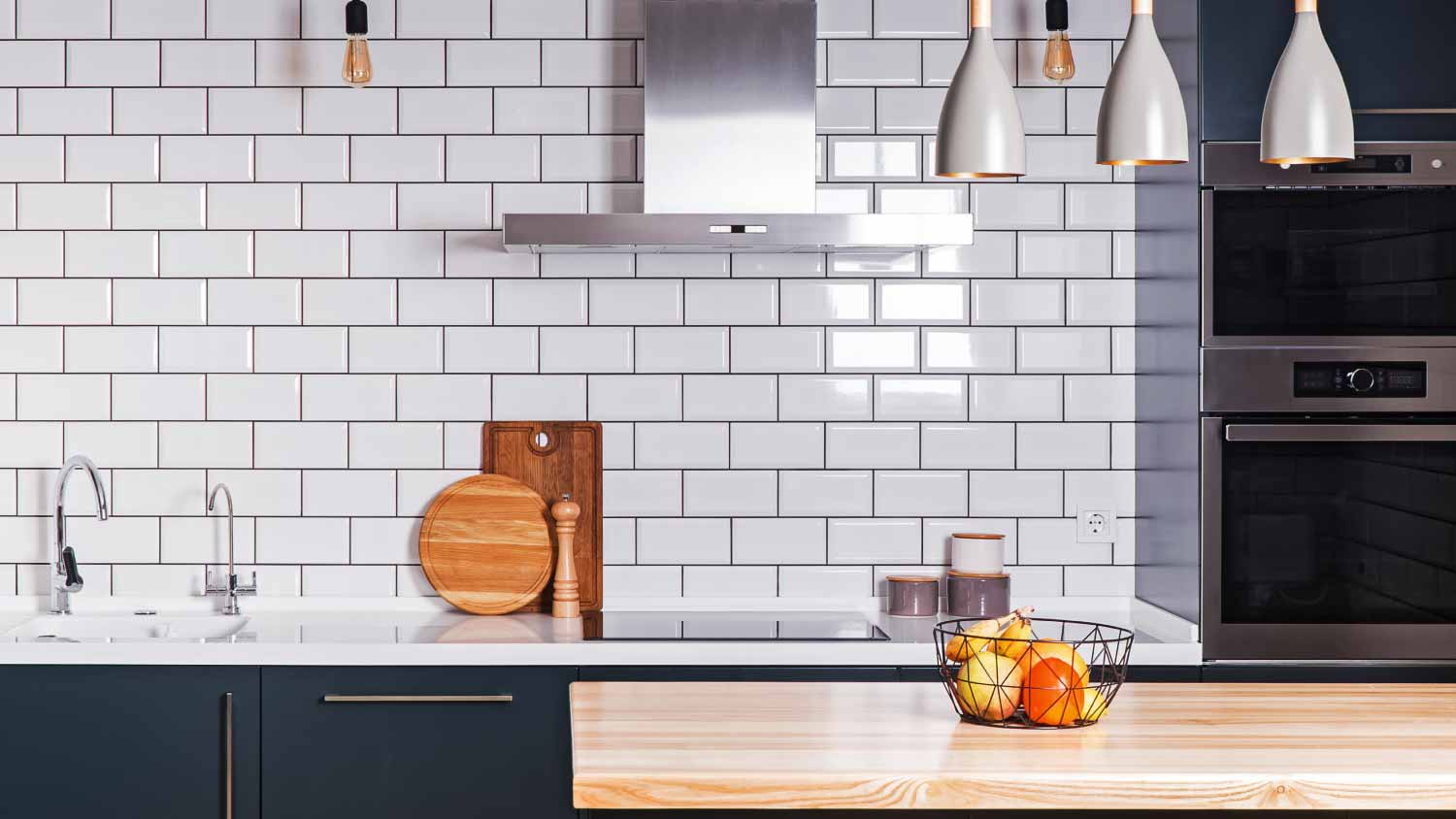
If you don’t mind the work and time required, you can create a unique backsplash alternative by using chunks of glass, stones, or tile to create a tile mosaic. Use glue to stick the pieces to the existing wall in a random pattern, mixing shapes and colors. Then use grout to fill in the spaces between the pieces and seal everything. This is a DIY-friendly option that comes at an affordable price point.
| Pros | Cons |
|---|---|
| Affordable | Time-consuming |
| Creative DIY job | Tough for novices |
| Various grout colors | Must clean grout |
Best for: Those who want to show off their individual creativity.
Although using concrete instead of granite countertops is a choice you may have considered, you may not have thought about adding a concrete layer as your backsplash. Adding concrete or plaster in the location of the backsplash delivers an industrial feel while using a highly durable material. Because of its neutral colors, it allows other items to stand out in the kitchen design.
| Pros | Cons |
|---|---|
| Highly durable | Needs sealing |
| Industrial design | Long time to cure |
| Neutral colors | Difficult installation |
Best for: Those who prefer an industrial look in the kitchen.
Create a unique, textured backsplash with round copper-colored tiles that resemble pennies—or use real pennies themselves. The tiles can be made of glass, ceramic, porcelain, or metal, offering durability and longevity. You’ll need time and plenty of grout to install this backsplash alternative, but the charm and visual interest will enhance the whole feel of your kitchen.
| Pros | Cons |
|---|---|
| Unique and visually appealing | Time-consuming installation |
| Durable | Requires extra maintenance |
| Long-lasting | Could tarnish |
Best for: An accent wall in a kitchen, small spaces, or unique aesthetics.
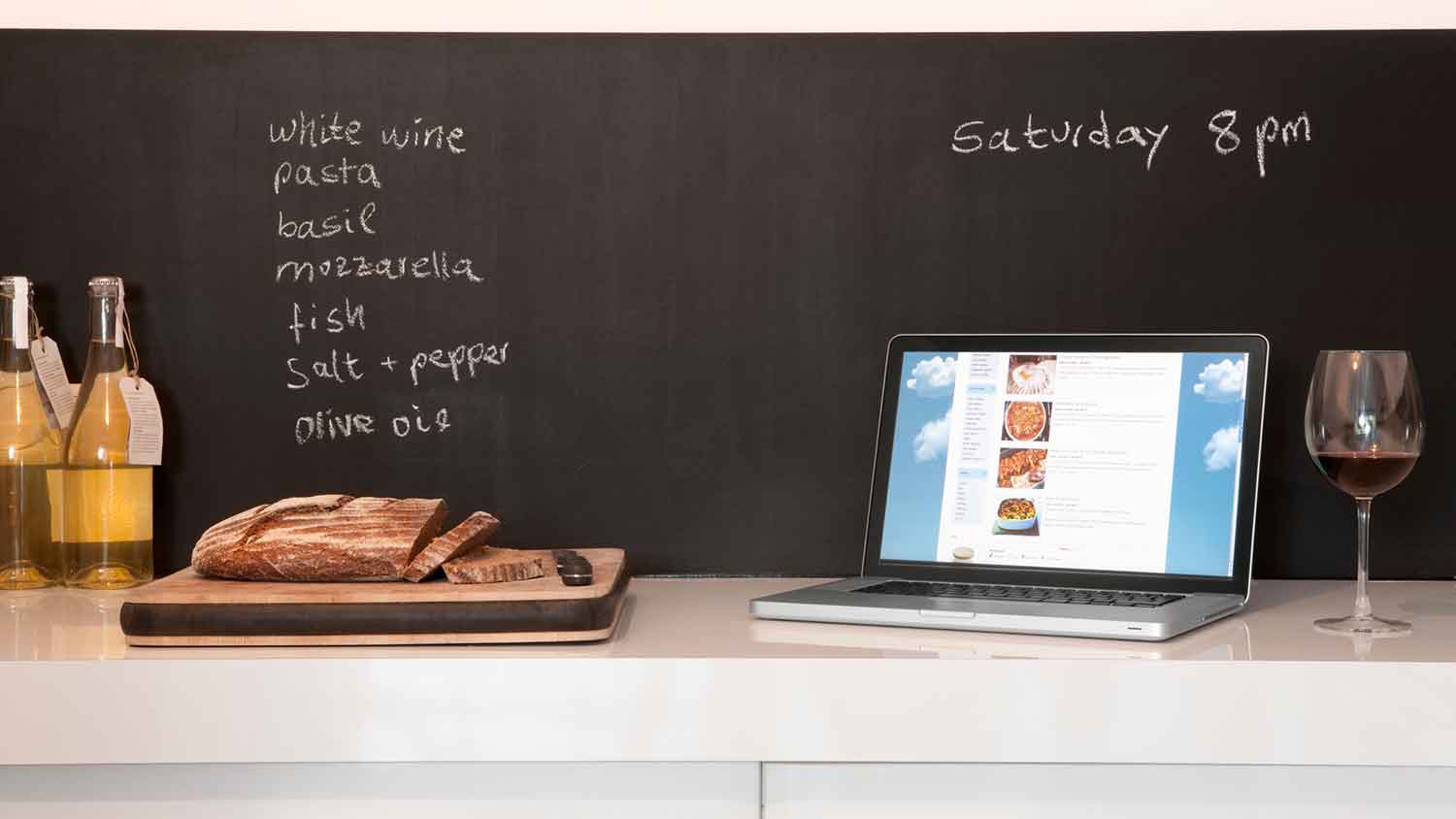
Cover your backsplash with specialized chalkboard paint to give you and your family the opportunity to write special messages—from motivational quotes to dinner plans. You can also create beautiful chalk art or put the kids to the task for a fun activity. A chalkboard paint backsplash is perfect for an artist’s home.
| Pros | Cons |
|---|---|
| Fun and versatile | Erasing can become messy |
| Erasable | Produces some dust |
| Inexpensive | Not as durable as regular paint |
Best for: Family homes, artists, and casual environments.
If you’re looking for easy DIY alternatives to a tile backsplash, consider peel-and-stick options. You can find peel-and-stick tiles made of plastic, vinyl, glass, or metal with an adhesive backing. Colors, styles, and patterns are endless and give you a chance to create a space you want at a fraction of the price of real tile.
| Pros | Cons |
|---|---|
| Easy to install | Not as durable as real tile |
| Mimics real tile | Looks different than real tile |
| Inexpensive | Doesn't increase the value of a home |
Best for: DIYers, budget-friendly homeowners, those looking for a kitchen refresh without a huge expense.
Wall decals are vinyl stickers that you can add to your backsplash for added color and design. They’re easy to adhere and remove, giving you options to switch them out over time. From florals to geometric designs, you can find wall decals to complement any kitchen style. They’re also inexpensive, making them one of the most affordable backsplash ideas around.
| Pros | Cons |
|---|---|
| Inexpensive and easy to install | Not as durable |
| Versatile and fun | May unstick over time |
| Temporary | Can fade over time |
| Come in a wide range of patterns and styles | Doesn't increase the value of a home |
Best for: DIYers, temporary designs, those looking for a kitchen refresh without a huge expense.
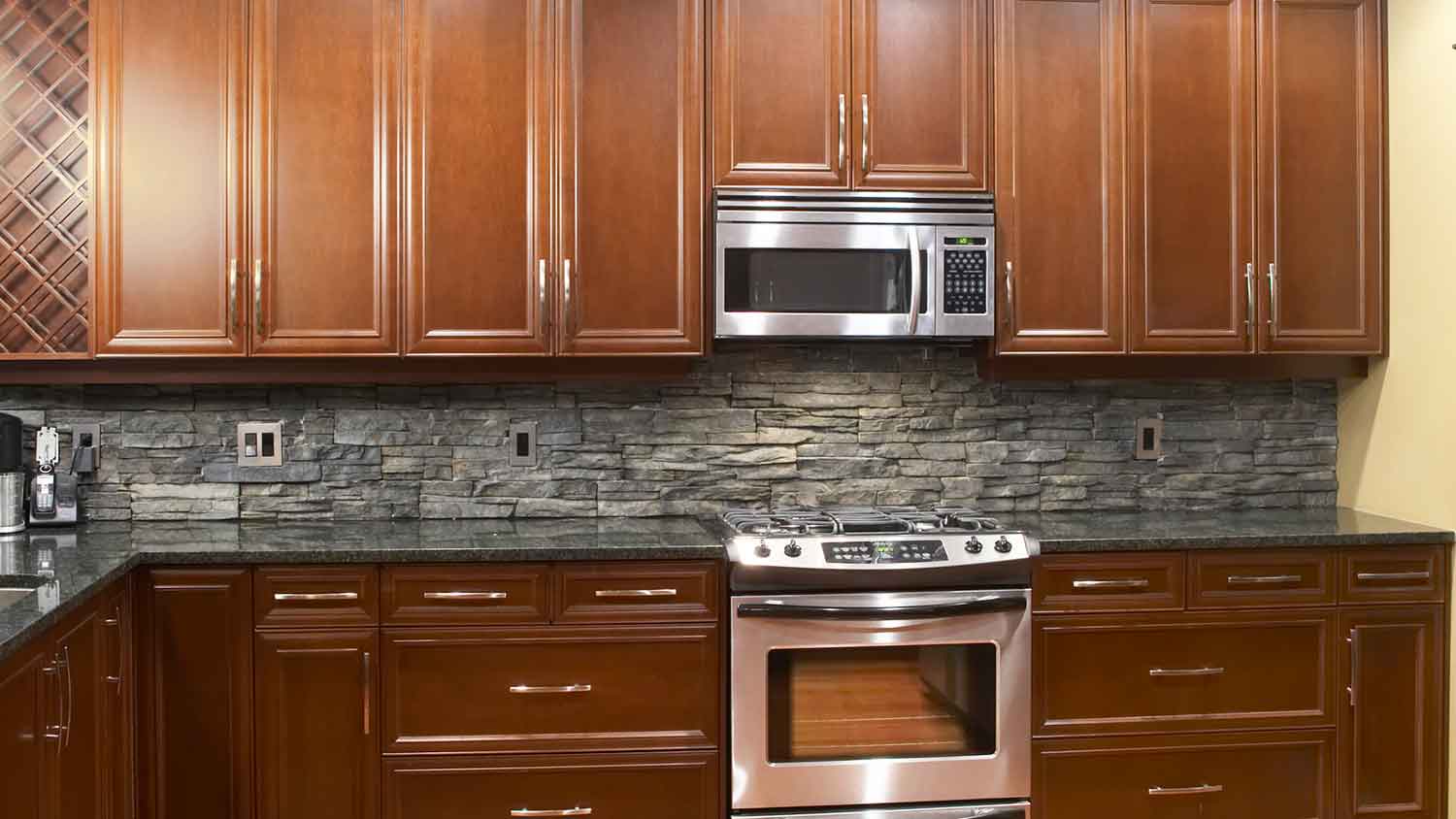
If you love the look and feel of stone but want a more cost-friendly option, consider a stone veneer backsplash. Stone veneer is a thin, decorative stone panel made of thinly sliced stone or manufactured stone. This backsplash alternative offers the appearance of natural stone without the weight (or price tag). Coming in a range of colors and patterns, stone veneer gives your kitchen depth, texture, and a sophisticated look.
| Pros | Cons |
|---|---|
| Look and feel of natural stone | Requires careful installation |
| DIY-friendly | Less durable than natural stone |
| Durable | More expensive than other options |
| Low maintenance | Some types may not look as real |
Best for: Those who want the elegant look of stone without the price tag.
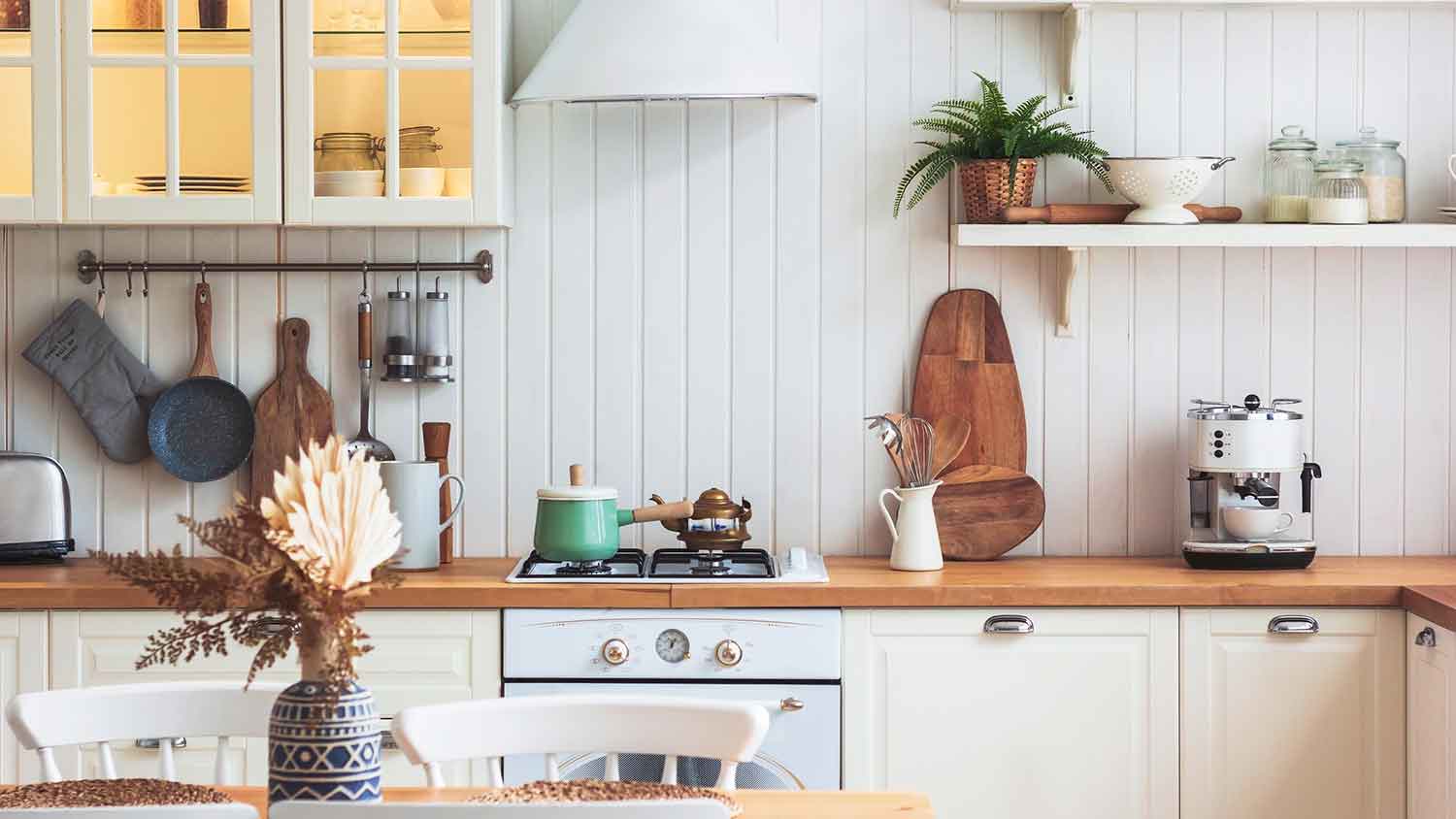
Beadboard is a type of paneling featuring vertical grooves or bumps that add texture to a wall without overcomplicating it. The panels are easy to install and give dimension to a room. Beadboard panels can be painted in different colors or left in a simple natural wood or white finish. They’re great for farmhouse, traditional, and cottage-style homes.
| Pros | Cons |
|---|---|
| Warm, cozy feel | Requires extra cleaning |
| DIY-friendly | Susceptible to moisture damage |
| Inexpensive | Prone to dings and scuffs |
Best for: Country-style homes, farmhouses, cottages, and warm aesthetics.
From vintage patterns to modern geometrics, create a vivid backsplash by stenciling the wall. Use the stencil to create a custom design on your backsplash for a personalized look. You’ll need a detailed eye and a careful hand, along with ample spare time. However, the results can be stunning when done right.
| Pros | Cons |
|---|---|
| Custom and unique | Not as durable as wallpaper |
| Budget-friendly | Requires time and precision to install |
| Creative freedom | Hard to get right with no imperfections |
Best for: Artistic homeowners, custom looks, and DIYers.
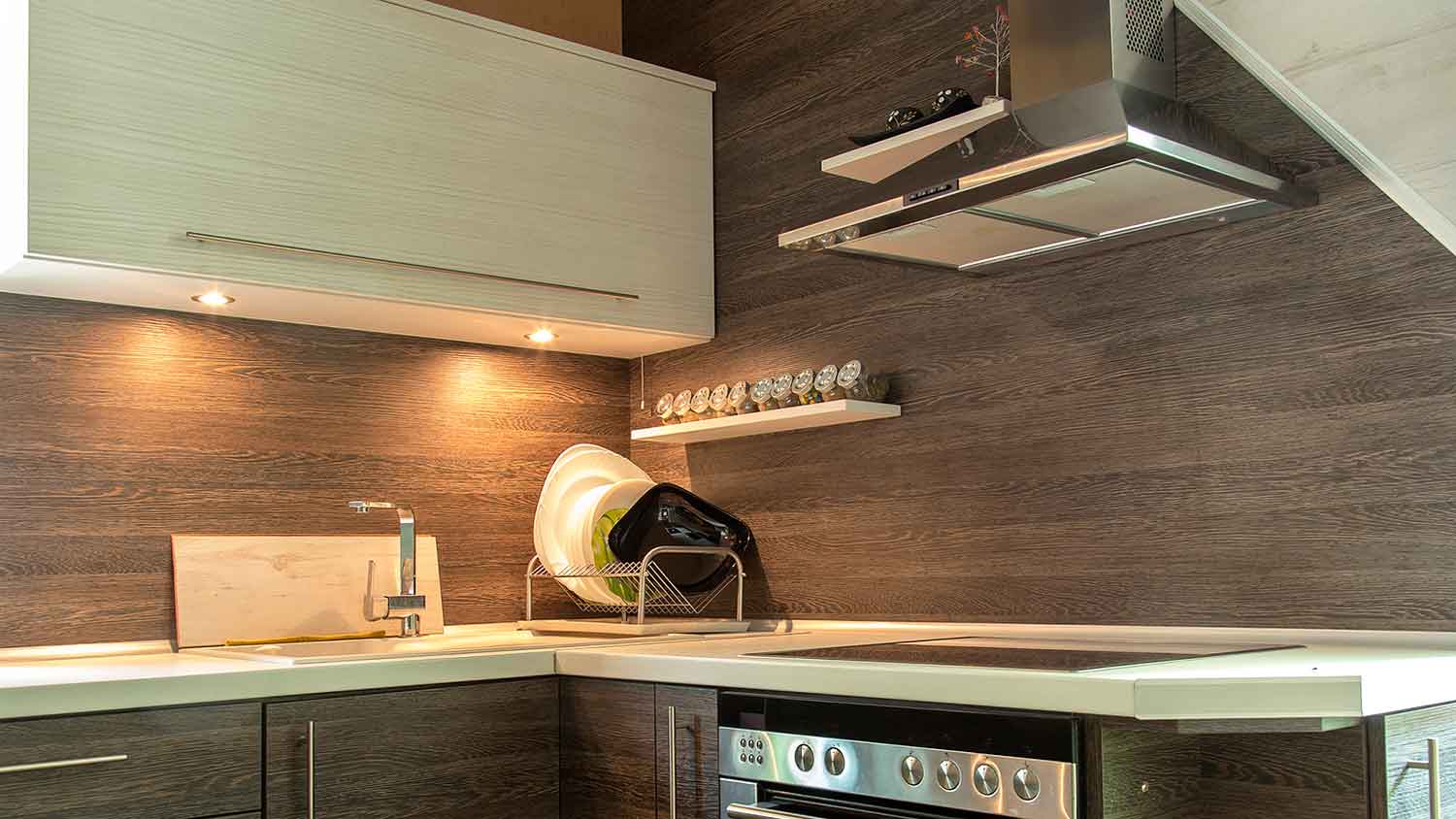
Laminate isn’t just great for floors—it’s a durable option for a kitchen backsplash, too. Find laminate wall panels that resemble wood, stone, or tile. Thanks to their moisture resistance and ease of installation, laminate makes an appealing alternative to tile backsplash.
| Pros | Cons |
|---|---|
| Easy to cut and install | Susceptible to some water damage |
| Affordable | Difficult to repair |
| Durable and low-maintenance | Can appear less natural |
Best for: Budget-conscious homeowners and DIYers.
Unlike traditional tile, subway tile is rectangular tile made of porcelain or glazed ceramic. It's incredibly durable and adds a chic look to your kitchen backsplash. You can lay them in a vertical or an alternating pattern, depending on your style. Subway tiles come in a range of colors and bring a luxurious aesthetic to your kitchen.
| Pros | Cons |
|---|---|
| Timeless, classic design | More expensive than other alternatives |
| Durable and long-lasting | Requires grout maintenance |
| More affordable than most tile | Requires professional installation or careful DIY |
Best for: Those who want a long-lasting, timeless solution.
The best compliment I could pay Ali of S&S Ceramic Tile would be to call him an old school craftsman. He is methodical in his work and takes no shortcuts. I learned he is the owner and sole employee of the business, and he takes on and completes one job at a time. He showed up every day on...
A very good company to work with: professional, reasonably priced, and willing to go above and beyond to satisfy the customer. We had rotted wood and new aluminum roof trim installed, and the result is perfect and done on time. I definitely recommend them and will certainly use them for...
The service was excellent! Norwin's trap caught the dangerous bob cat in short order. I am very thankful!
Brandon Burnette did such a great job. I'm so happy I had him as my worker today. Very nice and friendly young man. 10 star in my book.
We had LHR install a new roof and gutter system. While they were not the cheapest, they were considered the most reliable and fetish for using only high-value products that would last for many years. Additionally, they were highly professional and never tried to push their services or any...
They installed an outdoor cinema in my backyard and did an excellent job! Everything is well-organized!
Very knowledgable and fantastic to work with. Did subway tile in our kitchen, two shower surrounds, shower doors and accent tile by vanity. It all looks beautiful! Went out of his way to make sure our job got finished on time even with unseen set backs. Would definitely recommend!!
No problems except a cold weather delay on the ceramic tile floor which required staging and cutting in garage.
Was here the same day, very professional. Great job!
recaulk toilet. Half Bath caulk along base and edges of floor and toilet. Kitchen counter top recaulk along top of splac blook and bottom of splash bloc. Basement bath floor install caulk along floor base and edges of toilet and floor.Foyer floor steam clean all grout, remove and replace...
From average costs to expert advice, get all the answers you need to get your job done.

Damaged tiles should be fixed right away. In this guide, find out all of the different factors that affect your tile repair cost.

Whether it’s on your floor, walls, or shower, ceramic tile can add style to your space. So, how much does ceramic tile installation cost? Let’s break it down.

Tile varies dramatically in price, but there’s something for every budget. This guide will help you plan for tile installation costs, no matter the project.

Learn how to tile a shower with our comprehensive DIY guide. Following these step-by-step instructions will result in a professional-looking tile finish.

With the right planning and technique, you can achieve beautiful results from your wall tiling project. Find out how to install wall tiles.

Adding bullnose tile to your bathroom design can create a finished look and protect the tile edge. But what is bullnose tile and where can you use it?